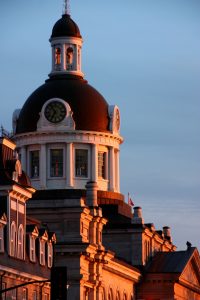Kingston, Ontario, is a beautiful city with a rich history, marked by its strategic location on the shores of Lake Ontario and its historical significance. However, like many cities, its past isn’t without its share of darker events that have shaped its identity. While Kingston is often celebrated for its stunning waterfront views, historical buildings, and thriving arts scene, it’s also important to reflect on the moments that have left scars on the community.
Let’s take a look at some of the more tragic and unsettling episodes in Kingston’s history.
- The Kingston Penitentiary and the Dark History of Canadian Prisons
The most well-known symbol of Kingston’s darker history is undoubtedly the Kingston Penitentiary, which opened in 1835 and operated for 178 years before it was closed in 2013. This was the oldest maximum-security prison in Canada and one of the most notorious correctional facilities in the world. During its years of operation, Kingston Pen became infamous for its harsh conditions, violence, and stories of abuse.
Notably, a series of infamous riots and escapes throughout the years gave the penitentiary its notorious reputation. The most infamous incident took place in 1971, when a group of inmates took hostages, leading to a bloody standoff. The prison’s dark history has been the subject of numerous books, documentaries, and tours, leaving a reminder of the prison-industrial complex’s brutal legacy.
- The Great Fire of Kingston (1840)
One of the most devastating events in Kingston’s early history was the Great Fire of 1840. It broke out on the night of October 9, 1840, and destroyed much of the downtown area. The fire ravaged homes, businesses, and public buildings, including the Kingston Market, and left thousands of residents homeless. The total loss was devastating, with some estimates suggesting over 1,000 people were left without shelter.
The aftermath of the fire prompted city-wide rebuilding efforts, but it was a hard hit to the local economy and left a lingering emotional impact on Kingston’s residents.
- The Kingston Riots (1837)
In the early 19th century, Kingston was embroiled in the turbulence of political unrest that swept across Canada. The Rebellions of 1837 were particularly significant, as they involved armed uprisings against the British colonial government. Kingston became the scene of several violent clashes between insurgents and British soldiers.
One of the most notable events was the Kingston Riot of 1837, which broke out in response to the harsh conditions of the colony. This uprising, though small compared to other rebellions in Upper Canada, left a deep scar in the social fabric of the city. It highlighted the tension between loyalists and reformers in the area and is a reminder of the instability during a time of political and social change.
- The 1917 Explosion at the Kingston Naval Dockyard
While the city was often seen as a peaceful and quiet hub, Kingston also had a dark connection to wartime events. During World War I, Kingston’s naval dockyard was a central military site, where ships and armaments were produced. On November 1, 1917, an explosion occurred at the naval facility, killing several workers and causing widespread panic in the area.
The explosion’s cause was suspected to be a mishap related to munitions or military-grade explosives, and while the exact details remain unclear, the tragedy left a lasting impact on the city, highlighting the dangers of wartime manufacturing.
- The Tragic Death of Margaret McKellar (1979)
In a quieter yet still heartbreaking incident, the death of Margaret McKellar in 1979 stands as one of Kingston’s most tragic moments. Margaret was a local resident who was tragically murdered in a senseless act of violence. The case shocked the community, especially considering her close ties to the city’s educational system, and has been remembered as one of Kingston’s most heart-wrenching unsolved crimes.
Though the crime was eventually solved and the perpetrator apprehended, the lasting emotional toll this tragedy had on the community is still felt today. It serves as a reminder of how quickly life can be upended by violence.
- The Death of Three Children in 2003
One of the most devastating recent tragedies in Kingston occurred in 2003, when three young children lost their lives in a house fire. The fire claimed the lives of siblings aged 7, 4, and 1, leaving the community in shock and mourning. The circumstances surrounding the fire and the sheer heartbreak of the loss left the city reeling for years afterward. The event brought together the local community, which rallied to support the family in the aftermath, but it remains one of Kingston’s darkest memories.
- The Impact of Indigenous Displacement
Kingston’s history is also intertwined with the legacy of colonialism and the displacement of Indigenous peoples. The Algonquin and Haudenosaunee (Iroquois) people had long inhabited the land around Kingston, but colonial expansion and the building of fortifications in the region led to the displacement of Indigenous communities. The establishment of Fort Frontenac in 1673 marked the beginning of a long history of loss, as Indigenous people were pushed out of their territories.
The repercussions of this displacement are still felt today by Indigenous communities in Kingston and beyond. This chapter in Kingston’s history is a painful reminder of the broader struggles of Indigenous peoples throughout Canada, and ongoing efforts toward reconciliation and healing remain a crucial part of the community’s future.
Conclusion: The City’s Dark Past and Hope for the Future
While Kingston has certainly had its fair share of challenges and tragic moments, the city has also shown resilience and the ability to rebuild and heal. The dark chapters of Kingston’s history remind us of the importance of remembering our past — both the good and the bad — as we move forward into a brighter future.
By acknowledging the tragedies that have shaped Kingston, we can foster a deeper understanding and compassion for the diverse stories that make up this incredible city. The lessons learned from these moments of darkness continue to resonate in the fabric of Kingston’s community, giving hope for a more inclusive and peaceful future.
Kingston is a city that has weathered many storms and learned from its darker moments, and continues to grow and thrive as a vibrant, dynamic community.


 Facebook
Facebook
 X
X
 Pinterest
Pinterest
 Copy Link
Copy Link

